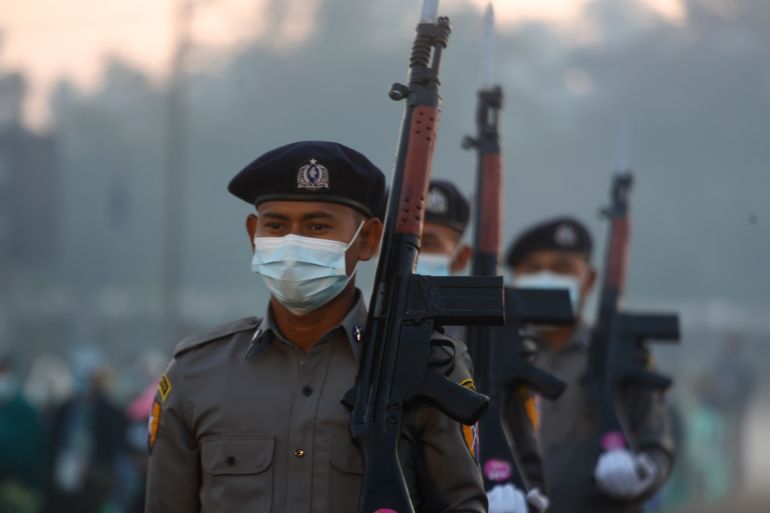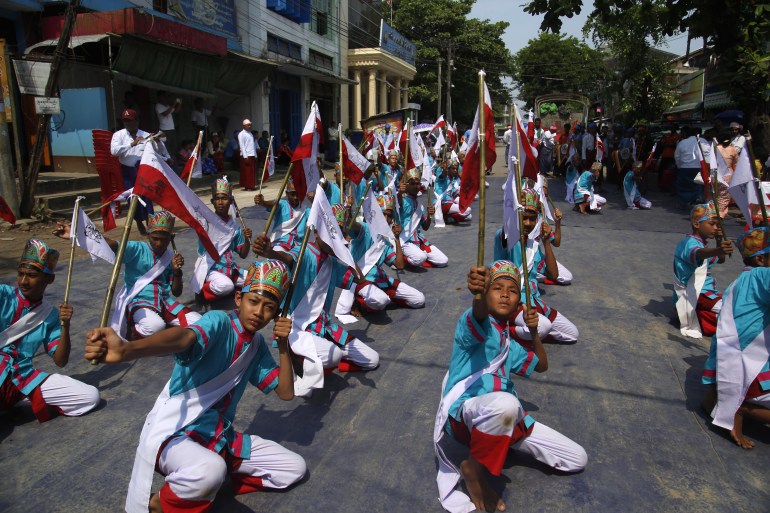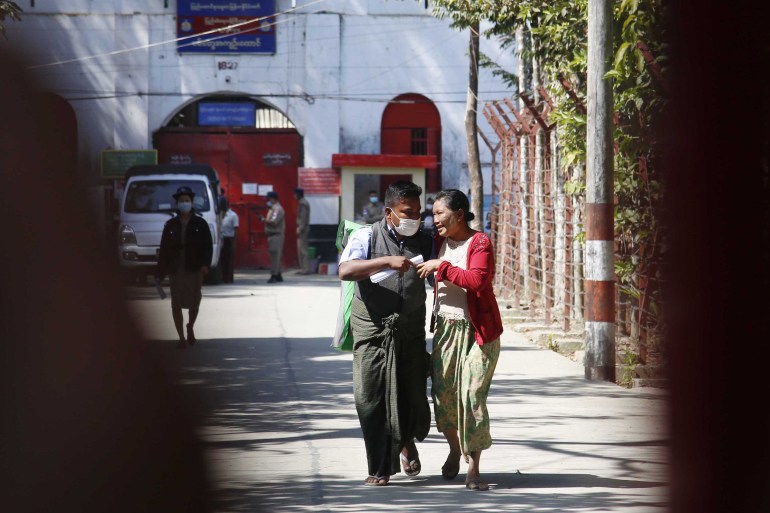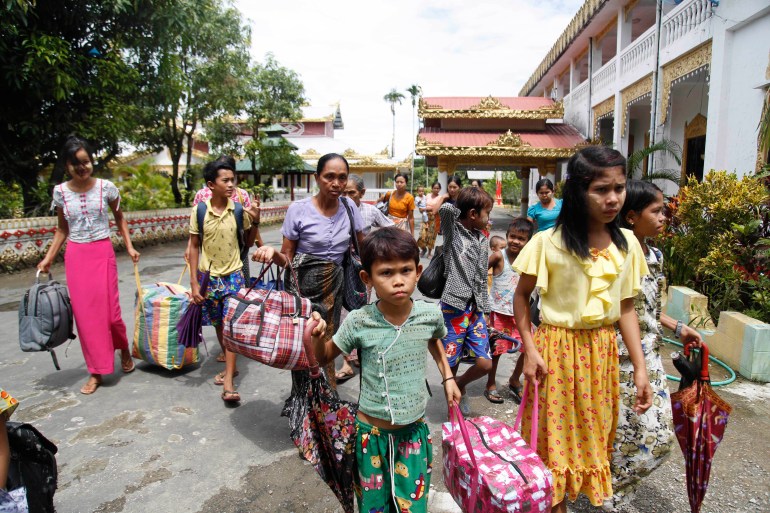Rumbles in Rakhine amid strains between Myanmar military, rebels
Recent skirmishes between Arakan Army and the military have raised concern about the stability of an informal year-long ceasefire.

Since Myanmar’s military staged a coup against Aung San Suu Kyi’s elected government on February 1, triggering mass unrest, the formerly restive far-western state of Rakhine has remained relatively peaceful.
But recent skirmishes have raised concern that an informal ceasefire agreed in the long-troubled area in November last year is starting to break down, even as armed rebellion surges in other parts of the country.
Keep reading
list of 4 itemsUS issues religious freedom ‘concern’ list, removes Nigeria
Myanmar students boycott classes following school reopening
US journalist Danny Fenster arrives in NY after Myanmar release
While fighting was reported on multiple days in the second week of November, Arakan Army (AA) Spokesperson Khaing Thu Kha only admitted that the rebel group was involved in one two-hour clash on November 9, after the regime’s troops “intentionally” entered an AA-controlled area.
“There was a brief clash to defend the territory,” Khaing Thu Kha said, adding that the situation had calmed and that the military did not seem to want to continue its advance.
For its part, the military has denied any confrontation with the AA, saying it had instead fought with the Arakan Rohingya Salvation Army (ARSA), the same Rohingya armed group that attacked a police outpost in 2017, sparking a brutal counterinsurgency that sent more than 700,000 Rohingya civilians fleeing across the border to Bangladesh. The crackdown is now the subject of an international genocide case.
“It did not happen with the AA,” military spokesman General Zaw Min Tun told Radio Free Asia on November 10. On November 15, ARSA issued a statement that it had been involved in fighting with the military on November 7, 9, and 11.
The AA is a more formidable adversary than ARSA, having fought the Myanmar military to a stalemate after two years of brutal conflict, described by many as the country’s fiercest civil war in decades.

Richard Horsey, senior adviser to the International Crisis Group, says while the ceasefire has mostly held for a year, the two sides’ objectives remain deeply at odds.
“The AA has used the ceasefire to reposition its forces and strengthen its administrative apparatus, and at some point the military will step in to enforce its red lines,” he told Al Jazeera. “The trigger for the recent clashes may have been a random event, but there is clearly scope for serious escalation.”
Tussle over trade
The fighting reportedly took place in Maungdaw township, near the border with Bangladesh.
Khaing Kaung San, executive director of Rakhine-based human rights group Wan Lark Foundation, said it may have been triggered by a tussle over control of trade routes.
He also said while the military may hesitate to fully confront the AA given it is facing “offensive attacks” from other armed groups throughout the country, it also cannot accept the AA’s demand for “greater autonomy” within Myanmar.
“If the fighting that happened in 2018-20 resumes, there will be more destruction and more internally displaced people,” Khaung Kaung San said.
Horsey agreed that should the military take on the AA, it could become “seriously overstretched”, allowing other resistance groups to make advances.
Although most analysts believe both sides in Rakhine hope to avoid a return to war, there are other signs that the ceasefire is under stress.
While the military government has been releasing political prisoners who were charged with “terrorism” for allegedly being affiliated with the AA, it has begun arresting people accused of being connected to the People’s Defence Force, a loose network of armed resistance groups that emerged after the coup.
Following the reported clashes in Rakhine, authorities have also reportedly begun hunting journalists and investigating local outlets Narinjara and Western News. Reporters from Western News have since gone into hiding. Crackdowns on local media were a common tactic deployed during the two-year conflict as well.
The AA, established in 2009 and one of dozens of ethnic armed groups operating primarily in Myanmar’s border areas, mostly represents ethnic Rakhine Buddhists, who make up the majority of the state’s population.
After the crackdown on the predominantly Muslim Rohingya, fighting intensified between the military and the AA in 2018, driven mainly by local grievances with the central government and a desire for greater political autonomy. The fighting forced tens of thousands from their homes, and nearly 1,000 civilians were seriously injured or killed by artillery shelling, gunshots, and landmine explosions, including more than 170 children, according to Radio Free Asia.
The violence only came to an end after the two sides had agreed to an informal ceasefire ahead of the 2020 election, amid a shared antipathy to Aung San Suu Kyi’s National League for Democracy (NLD) government.

The NLD’s government had designated the AA a “terrorist organisation” and had called on the military to crush the group. It had also excluded the AA from its landmark peace conference, blocked humanitarian assistance to conflict-affected people, and cancelled voting in many parts of the state.
Kyaw Lynn, a 24-year-old youth activist from Rakhine, told Al Jazeera that the NLD’s stance on armed conflict and political problems in Rakhine made most people feel like they were not really losing anything as a result of the coup, despite the mass protests and rebellions elsewhere in the country.
AA extends influence
In Rakhine, the turmoil has allowed the AA to further entrench its position while the military has been distracted.
Nyo Twan Awng, the AA’s deputy commander-in-chief, told Frontier Myanmar in August that the group had de facto power over two-thirds of the state and was now operating its own administrative and judicial systems.
The AA has also publicly committed to building an inclusive administration that incorporates the marginalised Rohingya.
Spokesman Khaing Thu Kha said that some of the group’s political wing, the United League of Arakan, has been involved in COVID-19 prevention, the repatriation of displaced people and drug rehabilitation programmes.
While the AA has avoided joining the anti-military revolution, it has condemned the coup and subsequent violent crackdowns on peaceful protesters.
“On the one hand the people could live peacefully without war for a year,” said Khaing Thu Kha. “On the other, what is happening in Myanmar is disgraceful and disappointing.”
Army chief Min Aung Hlaing detained Aung San Suu Kyi and many senior members of her government hours before the new parliament was due to convene in February.

The power grab has fuelled anti-coup protests in much of the country as well as a mass movement of civil disobedience. The military has responded with force and at least 1,270 people have been killed and more than 10,000 arrested, according to the Assistance Association for Political Prisoners, which is tracking the situation.
The AA said as early as April that there should be no street protests or activities linked to the Civil Disobedience Movement in the state to avoid distracting from the primary goal of establishing administrative control. Kyaw Lynn said the AA has a “huge influence” over the local population and few would go against such a request.
A prominent Burmese political and military analyst who requested anonymity for fear of arrest, told Al Jazeera: “The ceasefire in Rakhine State was a benefit to both. For the Myanmar military the end of the fighting allowed them to stage a coup, while for the AA it allowed them to build their military status and their own administration in Rakhine State.”
The analyst believes the military hoped the ceasefire would provide stability as it spun its voter fraud narrative and prepared to seize power.
But the generals would probably have hoped they could quash popular resistance before the AA was able to consolidate control over Rakhine. Nearly 10 months since the coup, the military government has been unable to bring the country completely under its control.
Shortly after the November clashes, Yohei Sasakawa, Japan’s envoy for reconciliation in Myanmar, met coup leader Min Aung Hlaing in Naypyidaw and travelled to Rakhine State.
As well as visiting Rohingya and Rakhine people displaced by the conflict, he held talks with AA leaders, urging them to avoid conflict. On November 16, the AA released a total of 15 police officers and soldiers.
But analysts say maintaining the ceasefire may prove increasingly tricky because the AA wants self-determination within Myanmar, and that is more than the generals are willing to accept.
“In order to achieve the AA’s political goals, they must choose the armed path,” the political analyst said. “It isn’t possible to get that from negotiation with the Myanmar junta,” he said.
The escalation in fighting elsewhere in the country might buy Rakhine some time.
But it might not take much to lead to renewed conflict in a region that has already endured years of violence.
“Whether the clash will intensify depends on the military,” warned AA spokesman Khaing Thu Kha. “If they come into any of the AA’s territory there will be war.”